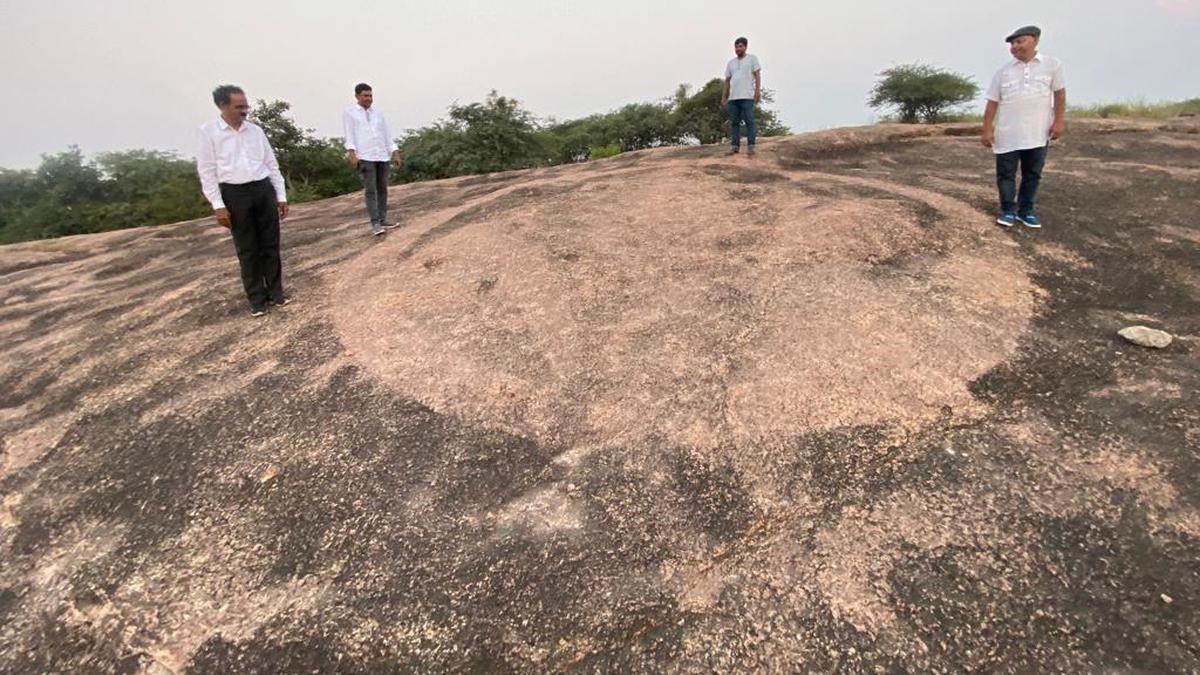Description

Disclaimer: Copyright infringement not intended.
Context
The recent discovery of a 3,000-year-old Iron Age geoglyph circle in Telangana represents a significant archaeological find, shedding light on the ancient cultural practices and artistic skills of the region's inhabitants.
Details
Findings
- The geoglyph circle was unearthed on the outskirts of Mudichu Thalapalli in the Medchal-Malkajgiri district of Telangana.
- It is etched on a low-lying granitoid hillock, measuring 7.5 meters in diameter with a well-defined circular shape.
- A 30-centimeter-wide rim surrounds the circle, and two triangles are positioned within it.
- It is suggested that this circle might have served as a model for megalithic communities in designing their circular burial sites.
- Apart from the geoglyph, the team identified several grooves believed to be from the Neolithic period, dating back to 4000 BCE, located five meters away from the geoglyph.
- Furthermore, within a one-kilometer radius of the geoglyph, the team discovered three prehistoric rock shelters adorned with depictions of bulls, deer, porcupines, and human figures wearing masks.
About Geoglyphs
- Geoglyphs are large designs or motifs produced on the ground, typically created by arranging stones, gravel, earth, or other durable elements to create a visual or artistic representation.
- These formations often span significant areas, and their designs can range from simple geometric shapes to intricate, detailed depictions of animals, humans, or complex symbols.
- Geoglyphs have been found in various parts of the world, with some of the most famous examples located in South America, particularly in the Nazca Lines of Peru.
- While the purpose of geoglyphs remains a subject of debate, they are widely recognized for their historical and cultural significance.

History and Discovery:
- Geoglyphs have a rich history dating back thousands of years.
- The earliest known geoglyphs are believed to have been created by ancient civilizations, with some examples dating back to prehistoric times.
- They have been discovered in diverse regions such as South America, North America, Europe, Africa, and the Middle East.
Types of Geoglyphs:
Geoglyphs can be categorized based on their form, purpose, and the materials used in their construction. Some common types include:
- Pictorial Geoglyphs: These depict various forms such as animals, humans, plants, or mythological creatures.
- Geometric Geoglyphs: Consist of patterns, lines, and shapes with geometric precision.
- Effigy Geoglyphs: Represent anthropomorphic or zoomorphic figures, often of religious or cultural significance to the ancient societies that created them.
Purpose:
- Some proposed theories include religious or ceremonial significance, astronomical or calendrical functions, territorial markers, or artistic expressions reflecting the cultural beliefs and practices of the societies that constructed them.
Notable Examples:
- Nazca Lines, Peru: Located in the Nazca Desert, these extensive geoglyphs are renowned for their intricate designs of animals, birds, and geometric shapes. The purpose behind their creation remains a subject of ongoing research and debate.
- Atacama Giant, Chile: A large anthropomorphic geoglyph situated on a hillside in the Atacama Desert, the figure is thought to represent a deity or an ancient astronomical calendar.
- Uffington White Horse, England: A highly stylized prehistoric hill figure representing a horse, created by cutting trenches into the hillside and filling them with crushed white chalk.
Cultural Significance:
- Geoglyphs play a significant role in understanding the cultural practices, beliefs, and societal structures of ancient civilizations.
- They contribute to the collective human heritage, providing valuable insights into the artistic, spiritual, and technological achievements of past societies.
.jpg)
Conclusion
Geoglyphs represent an intriguing aspect of human history, serving as a testament to the creativity and ingenuity of ancient civilizations. While many aspects of their origins and meanings remain shrouded in mystery, ongoing research and advancements in technology continue to shed light on these enigmatic creations, fostering a deeper understanding of the diverse cultures that produced them.
|
PRACTICE QUESTION
Q. Explain the cultural and historical significance of geoglyphs worldwide, highlighting their diverse forms, potential functions, and contributions to the understanding of ancient civilizations and their artistic and ritualistic practices. (250 Words)
|







